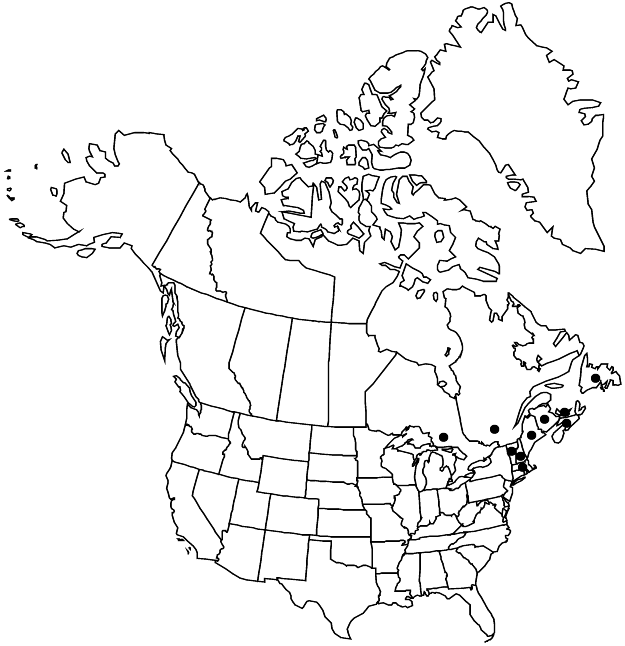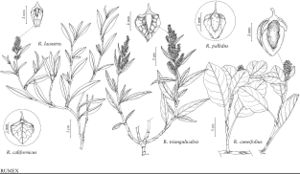Rumex pallidus
Fl. Boston. ed. 3, 153. 1840.
Plants perennial, glabrous, with vertical rootstock, occasionally with short-creeping rhizomes. Stems ascending or erect occasionally almost procumbent, usually producing axillary shoots below 1st-order inflorescence or at proximal nodes, 30–60 (–80) cm. Leaf-blades linear-lanceolate, 10–20 (–22) × 1–3.5 (–4.5) mm, usually ca. 7–10 times as long as wide, widest near middle, thick, coriaceous, base cuneate, margins entire, flat or slightly undulate, apex acute. Inflorescences terminal and axillary, terminal usually occupying distal 1/5–1/3 of stem, rather dense or interrupted in proximal 1/2, usually broadly paniculate (distal branches simple, proximal ones usually with few 2d-order branches). Pedicels articulated in proximal 1/3 or almost near base, filiform, 4–6 mm, not more than 2–2.5 times as long as inner tepals, articulation indistinctly swollen. Flowers 10–20 in whorls; inner tepals, broadly ovate-triangular or almost deltoid, occasionally broadly triangular, (2.5–) 3–4 × 2–3.5 mm, base truncate or round, occasionally indistinctly cordate, margins entire or indistinctly erose, apex obtuse or subacute; tubercles 3, equal or subequal, all tubercles, or at least largest tubercle pale, subequal to inner tepals or slightly narrower than inner tepals, often minutely verrucose. Achenes brown or dark reddish-brown, 2–3 × 1–1.5 mm. 2n = 20.
Phenology: Flowering late spring–summer.
Habitat: Coastal marshes and dunes, sandy and rocky sea beaches
Elevation: 0 m
Distribution

N.B., Nfld. and Labr. (Nfld.), N.S., Ont., P.E.I., Que., Maine, Mass., N.H., Vt.
Discussion
Rumex pallidus is restricted to northeastern North America. Specimens with more “strict habit, larger leaves, and more erect fruiting branches” reported by K. H. Rechinger (1937) from Alaska and Yukon as this species belong instead to R. sibiricus (E. Hultén 1941–1950, vol. 4). Those species, as well as R. subarcticus and R. hultenii Tzvelev, represent a rather natural northern group of the R. salicifolius aggregate. The hybrid R. pallidus × R. triangulivalvis was reported from the western part of New York (R. S. Mitchell 1986).
Selected References
None.
Lower Taxa
"/2" is not declared as a valid unit of measurement for this property."+-2.5timesaslongasinnertepals" is not declared as a valid unit of measurement for this property.
